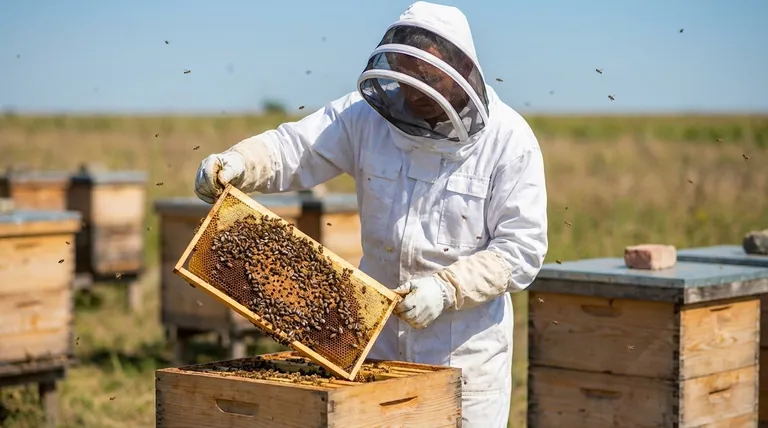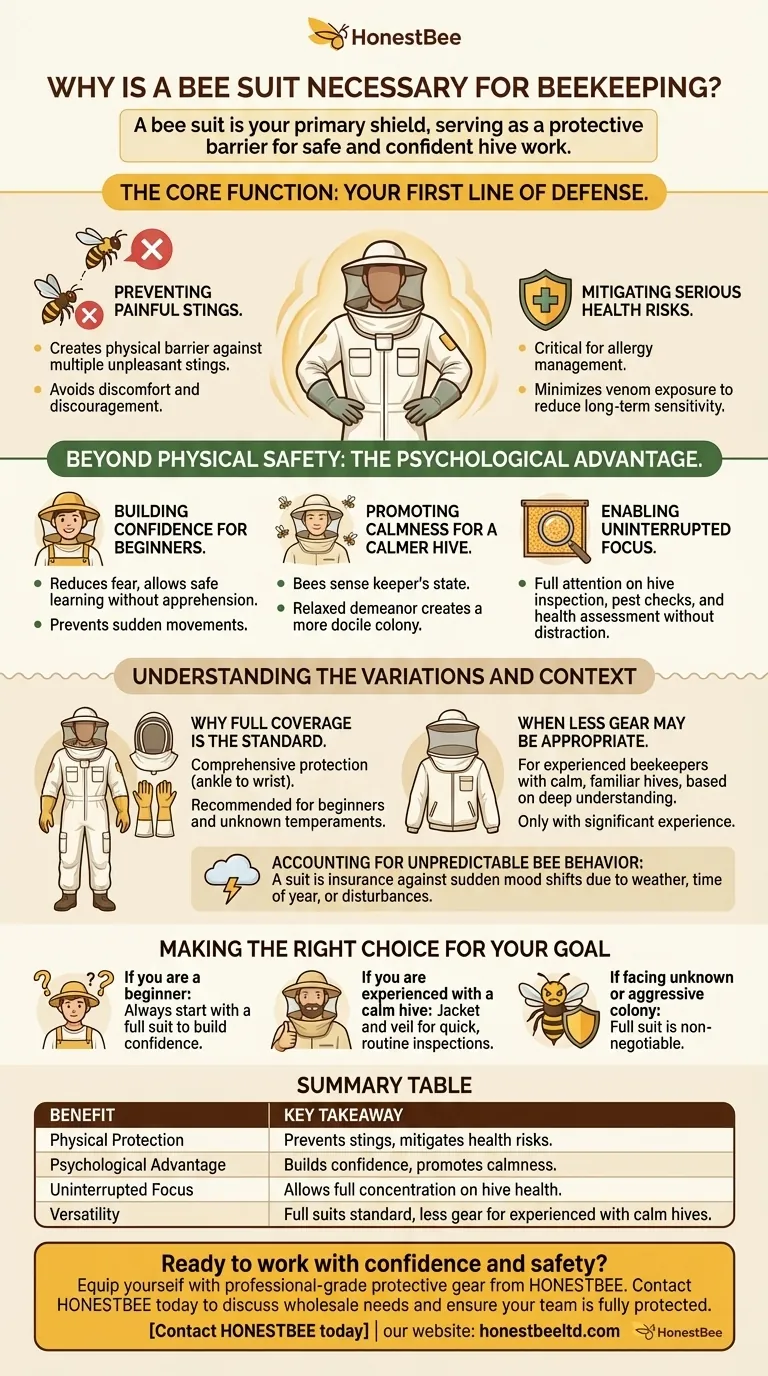A bee suit is necessary because it serves as your primary shield against stings, enabling you to work safely and confidently around your hives. This protective barrier is essential for preventing not only pain but also potentially serious allergic reactions to bee venom, allowing you to focus on the health of your colony without fear.
A bee suit is more than just physical armor against stings. It is a critical tool that fosters the calmness and confidence required for effective hive management, turning a potentially stressful interaction into a focused and enjoyable experience.

The Core Function: Your First Line of Defense
A bee suit's most obvious purpose is to prevent stings. This protection operates on multiple levels, from avoiding simple discomfort to mitigating significant health risks.
Preventing Painful Stings
The most immediate benefit is the prevention of pain. Bee stings are unpleasant, and multiple stings can make hive inspections an ordeal, discouraging you from properly tending to your bees.
A proper suit covers you from head to toe, creating a physical barrier that bees cannot penetrate.
Mitigating Serious Health Risks
For some individuals, a bee sting is more than just a painful annoyance. A suit is a critical piece of safety equipment for anyone with a known allergy to bee venom.
Even for those who are not allergic, developing a sensitivity over time is possible. A suit minimizes your exposure to venom, reducing this long-term risk and ensuring beekeeping remains a safe activity.
Beyond Physical Safety: The Psychological Advantage
The value of a bee suit extends far beyond physical protection. It has a profound psychological impact that directly influences both your behavior and the behavior of your bees.
Building Confidence for Beginners
For a new beekeeper, apprehension is natural. A full bee suit provides a wearable safety barrier that allows you to learn and interact with the colony without the constant fear of being stung.
This confidence is crucial, as beginners are more likely to make sudden movements or mistakes that could alarm a hive. The suit provides the grace period needed to learn the craft safely.
Promoting Calmness for a Calmer Hive
Bees are highly sensitive to the state of their keeper. If you are stressed or nervous, they will perceive you as a threat and become more defensive.
By removing the fear of stings, a bee suit helps you remain calm and deliberate in your movements. This relaxed demeanor is communicated to the colony, resulting in a more docile hive and a safer experience for everyone.
Enabling Uninterrupted Focus
When you aren't worried about being stung, you can dedicate your full attention to the task at hand.
This allows you to properly inspect the brood pattern, check for pests like varroa mites, and assess the colony's food stores without distraction. Better focus leads to better beekeeping.
Understanding the Variations and Context
While a bee suit is essential, the specific type and amount of gear you wear can vary based on experience and the specific situation.
Why Full Coverage is the Standard
A full, jumper-style suit that covers you from ankle to wrist, combined with a veil and gloves, offers the most comprehensive protection. This is the recommended standard, especially for beginners or when working with a hive of unknown temperament.
When Less Gear May Be Appropriate
Highly experienced beekeepers who are intimately familiar with their colonies may sometimes opt for less protection, such as only a jacket and veil. This decision is based on a deep understanding of bee behavior and the specific temperament of a particular hive on a given day.
This approach should only be considered after gaining significant experience and confidence.
Accounting for Unpredictable Bee Behavior
Even the most gentle colony can become defensive. Factors like weather, the time of year, a recent disturbance, or a perceived threat can change a hive's mood instantly.
A bee suit acts as your insurance policy against this unpredictability, ensuring you are prepared for any sudden shifts in temperament.
Making the Right Choice for Your Goal
Your choice of protective gear should be dictated by your experience level and the temperament of the colony you are working with.
- If you are a beginner: Always start with a full bee suit, including a veil and gloves, to build confidence and ensure maximum safety while you learn.
- If you are an experienced beekeeper with a calm hive: You might choose to wear just a jacket and veil for quick, routine inspections.
- If you are facing an unknown or aggressive colony: A full suit is non-negotiable, regardless of your experience, to guarantee your safety.
Ultimately, wearing a bee suit empowers you to be a better, more attentive, and more confident beekeeper.
Summary Table:
| Benefit | Key Takeaway |
|---|---|
| Physical Protection | Prevents painful stings and mitigates serious health risks from venom. |
| Psychological Advantage | Builds confidence for beginners and promotes calmness for a calmer hive. |
| Uninterrupted Focus | Allows beekeepers to fully concentrate on colony health and pest inspection. |
| Versatility | Full suits are standard for safety; experienced beekeepers may use less gear for calm hives. |
Ready to work with confidence and safety?
Equip yourself and your operation with professional-grade protective gear from HONESTBEE. We supply durable, reliable beekeeping suits and equipment designed for the demands of commercial apiaries and distributors.
Contact HONESTBEE today to discuss your wholesale needs and ensure your team is fully protected.
Visual Guide

Related Products
- Cotton Beekeeping Suit and Round Hat with Veil Bee Keeper Protective Gear
- Beekeeping Jacket with Hood and Veil for Beekeepers
- White Beekeeping Protective Suit and Hat with Fencing Veil for Beekeepers
- Professional Beekeeping Suit for Kids and Girls Childrens Bee Keeper Suit
- Heavy Duty Cowboy Beekeeper Hat with Visibility Veil Outdoor Professional Beekeeping Protective Gear
People Also Ask
- Why is white the predominant color in bee suit designs? | Key to Hive Calm & Beekeeper Safety
- How should a bee suit be cleaned? Protect Your Investment and Ensure Apiary Safety
- What is recommended for beginners in beekeeping regarding protective clothing? A Complete Safety Guide for New Beekeepers
- What are bee suits made of? Choosing the Right Material for Maximum Protection & Comfort
- Do beekeeping suits completely prevent stings? Maximize Your Apiary Safety with the Right Gear



















